オトシン・ネグロ (Called Otocin negro in Japan)
Otothyropsis piribebuy
国内繁殖個体。原産地はブラジル、サンパウロ州など。
Bred in Japan. Originally distributed in State of São Paulo in Brazil.

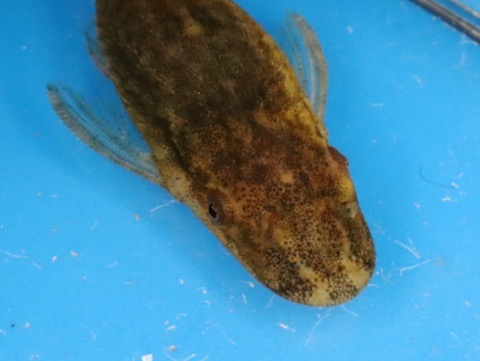


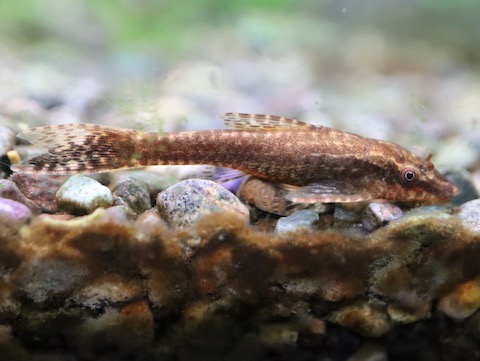
雌雄は体型で判断できると思います。中段左がオス、右がメス。
Middle left, male; middle right, female.
オトシン・ネグロの繁殖
Breeding of Otothyropsis piribebuy
pHを下げると産卵しやすく、稚魚は産卵箱などに隔離した方が育ちやすいようです。
水槽:36 x 22 x 26 cm
フィルター:底面、エアリフト、大磯砂
水質:pH=6.0-6.5、GH=5(水道水を活性炭浄水器に通し0.005%程度のリン酸二水素ナトリウム: NaH2PO4を溶かしたもの)
水温:25℃
照明:LED、7時間/日
2019年12月末、メスが抱卵していると思われる国内繁殖個体2ペアを繁殖用水槽へ導入。はじめは水質調整なしでpH=7.5、ガラス面の藻類が多かったためエサは与えず、徐々にpHを下げました。数日で藻類は食べ尽くされ、pHも下がったタイミングで配合使用を与えると、すぐにガラス面に付着した卵が見つかりました。この日を0日目とし、親魚を取り出しました。2020年2月の2回目の産卵では、同じ親魚2ペアをpH=7.5程度の水槽から6.5程度の水槽へ数時間の水合わせで移すと2日後に産卵し、その次の日にも追加の産卵がありました。1回目は、親魚を取り出したあと、稚魚を水槽に残したままにしましたが、7日目前後から目に見えて稚魚の数が減ってしまいました。ネット情報を参考に、2回目は早めに稚魚を産卵箱に隔離しましたが、この方が生存率が高く成長も速いと思います。想像ですが、成魚は砂利の上のエサを食べますが稚魚はあまり食べず、栄養が不足するのではないでしょうか。プラスチックの平らな底の産卵箱では、底面上のエサを食べるのが観察できます。その後、同じ親魚は、特にpH調整をしなくても水槽移動などの後に産卵するようになり、卵も孵化しています。
Tank size: 36 x 22 x 26 cm.
Filer: Air-lift undergravel with Oiso-sand.
Water condition: pH=6.0-6.5, GH=5. (About 0.005% sodium dihydrogen phosphate: NaH2PO4 in charcoal filtrated tap water).
Temperature: 25℃
Lighting: LED, 7 hours/day.
December 2019, I set two bred pairs in a breeding tank. At the bigining the pH was 7.5 and it was lowered day by day to 6.0. After they wiped out algae on the glass in several days, I used dry foods, and soon I found eggs on the glass. This day was defined as day 0. In the second time (Feb. 2020), they laid eggs more easily soon after transferred to a tank with pH=6.5. The fry survived and grew better when they were isolated in a small plastic case than left in the main tank, probably because they could pick up more foods on the plastic bottom than on the gravel. After that, the same parent fish lay eggs without pH conditioning just after moved to another tank, and the eggs hatch in the water.

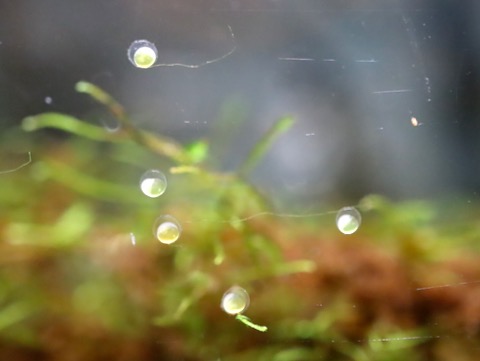
0日目。ガラス面に約30個の卵を見つけました。親魚は取り出しました。
Day 0. I found about 30 eggs on the glass, and removed the parental fish.
1日目。すでに微かな心臓の拍動が見られます。デジカメのスーパーマクロモードで撮影しました。
Day 1. Faint heart beat can be seen already. This video was recorded using the super macro mode of a disital camera.
2日目。胚の形もはっきりし、心臓の拍動も力強くなっています。
Day 2. The embryos are developping, and the heart beat is strong.
3日目。孵化しました。ケンミジンコをはじきとばしています。
Day 3. Hatched. It flichs a cyclops.

4日目。温度計にとまる稚魚。
Day 4. A fry on a thermometer.

5日目。Day 5.


9日目。1週間目くらいから稚魚の数が減り始めました。観察していると、力尽きるようにガラス面から離れ、ふわっと墜落するように沈んでいく様子が見られました。エサが十分に摂れていないのでしょうか。ネットで調べてみると、本水槽では稚魚が育ちにくく、産卵箱などに隔離すると生存率が上がるようです。稚魚はまだ小さく、すり抜けないようにスリットのない産卵箱を使いました。エサは、粉末の配合飼料や冷凍ワムシを与えています。
Day 9. Around one week after the eggs were lain, the fry started to disappear. I transferred the fry to a small plastic case to improve the survival rate, accoding to internet information. I feed them with dry powder and frozen Branchionus.
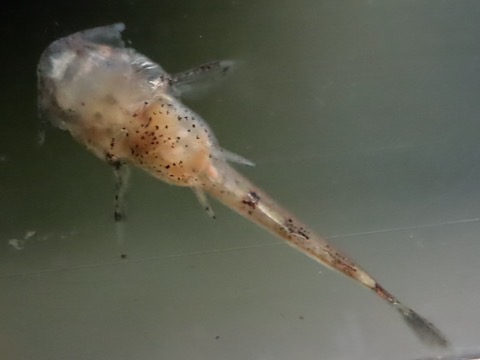
16日目。Day 16.

23日目。Day 23.

29日目。方眼は1mm。
Day 29. Grid, 1 mm.

32日目。Day 32.

50日目。Day 50.

2回目の産卵、0日目。1回目と同じ親魚をpH=6.5程度の水槽に移すと2日目と3日目に産卵しました。
Day 0 of the second clutch breeding. This time, the same parental fish as the first clutch laid eggs in a couple of days after they were transferred to a breeding tank with pH=6.5.

1日目。Day 1.

2日目。Day 2.

3日目。Day 3.

4日目。今回は早めに産卵箱へ移動しました。
Day 4. This time, the fry were moved to a small case earlier.

5日目。Day 5.

11日目。Day 11.

18日目。Day 18.


25日目。成長の速いものから60cm水槽へ放流しました。
Day 25. Ones growing faster are released into a bigger tank.

32日目。残りの幼魚も成長しています。
Day 32. Other ones are also growing up.
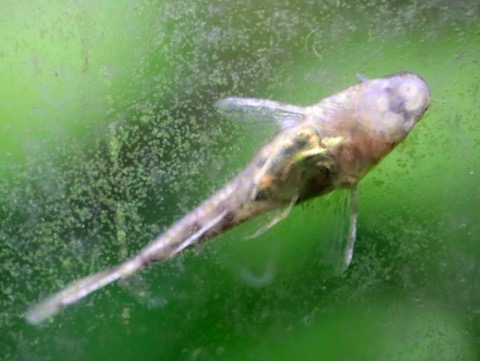
47日目。ガラス面の藻類を食べています。
Day 47. Eating algae on the glass.


2021年夏、上と同じ親魚から、また採仔しました。今回は、初めからプラケース内で産卵させました。特に水質調整はせず、pH=7.4、GH=5程度でしたが、数日で産卵しました。産卵当日(0日目)の画像。
In the summer of 2021, the same parental fish as above spawned once again. This time they were introduced into a small plastic case. Though the water was not conditioned (pH=7.4, GH=5), they spawned in several days. Photos of day 0.
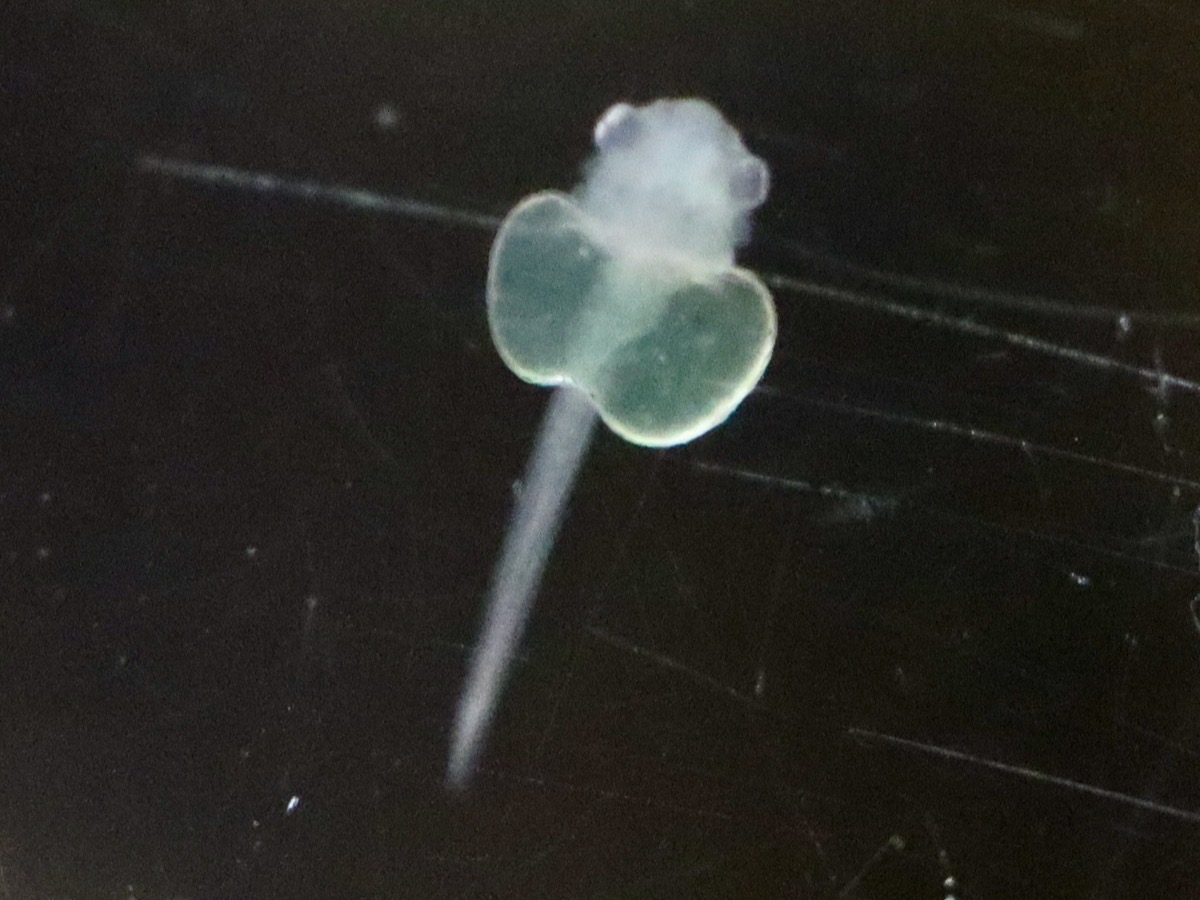

産卵後2日目。
Two day after the spawning.

9日目。Day 9.

49日目、成長は早く、ほぼ成魚です。
Day 49, they grew fast and now are almost adults.